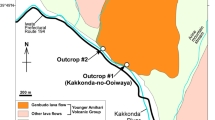Abstract
Engineering studies on Buckboard Mesa in Nevada have included extensive coring and borchole photographing in a late Cenozoic basalt flow. The basalt was evidently extruded from a fissure, now marked by a cinder cone, localized in the moat of the Timber Mountain caldera. It is an olivine-bearing andesitic basalt with a moderately high potassium content.
Away from complications near the vent only a single flow is present. Distributaries from the main channel branch to clusters of lava toes at the flow terminus. A vesicular facies overlies a dense facies in general, but alternating layers formed in an early flow stage complicate the stratigraphy.
Structures formed in a transitional stage are flattened vesicles, layers of vesicles, and lineated vesicles. These flow structures commonly parallel concentric flattened cylinders of the various rock types. The cylindrical structure is apparently fundamental to lava flow mechanics. In the brittle stage, an orthogonal system of three sets of fractures developed in the lava parallel and perpendicular to the flow layering. Similar flow channels with cylindrical flow structure and related fractures are present in Columbia River basalt and elsewhere.
Similar content being viewed by others
References Cited
Anderson, E. E., 1962,Preliminary petrographic study of rocks from basalt mesa, Nevada Test Site (Appendix E). Project Buckboard, Sandia Corporation, Report SC-4675 (RR), pp. 303–307.
Buck, A. D., Marler, G. U., andSaucter, K. L., 1963,Project Danny Boy, Petrographic Examination and Physical Tests of Selected Cores, U. S. Army Engineer Waterways Experiment Station Miscellaneous Paper 6–570, 73 pp.
Carr, W. J., 1964,Structure of Part of the Timber Mountain Dome and Caldera, Nye County, Nevada. U. S. Geological Survey Professional Paper 501-B, pp. 16–19.
Luft, S. J., 1964,Mafic Lavas of Dome Mountain, Timber Mountain Caldera, Southern Nevada. U. S. Geological Survey Professional Paper 501-D, pp. 1472-21.
Lutton, R. J., 1968,Project Dugout, Geologic and Engineering Properties Investigations, U. S. Atomic Energy Commission Report PNE 602F, 182 pp.
Lutton, R. J., andGirucky, F. E., 1966,Project Sulky, Geologic and Engineering Properties Investigations. U. S. Atomic Energy Commission Report PNE 720F, 130 pp.
Lutton, R. J., Girucky, F. E., andHunt, R. W., 1967,Project Pre-Schooner, Geologic and Engineering Properties Investigations, U. S. Army Corps of Engineers Report PNE 505F, 204 pp.
Nichols, R. L., 1936,Flow-units in Basalt. Journal of Geology, vol. 44, p. 617–630.
Wentworth, C. K., andMacDonald, G. A., 1953,Structures and Forms of Basaltic Rocks in Hawaii, U. S. Geological Survey Bulletin 994, 98 p.
Author information
Authors and Affiliations
Rights and permissions
About this article
Cite this article
Lutton, R.J. Internal structure of the Buckboard Mesa basalt. Bull Volcanol 33, 579–593 (1969). https://doi.org/10.1007/BF02596526
Received:
Issue Date:
DOI: https://doi.org/10.1007/BF02596526




